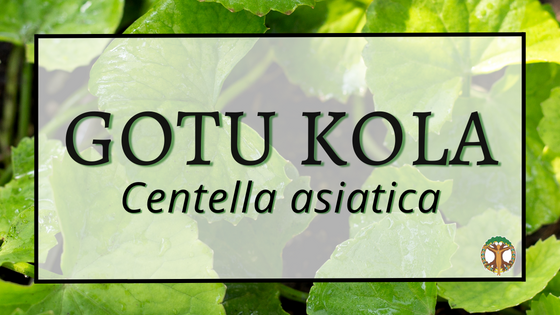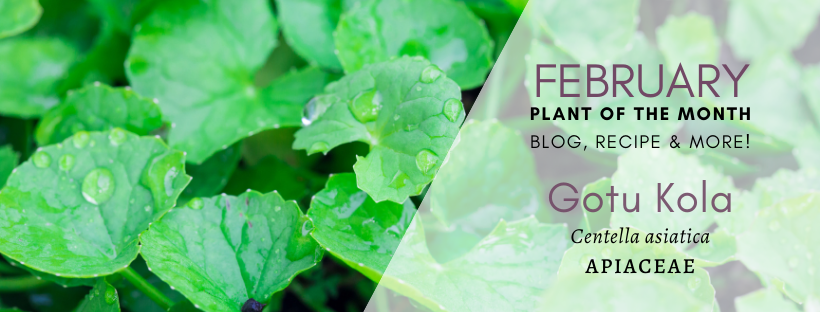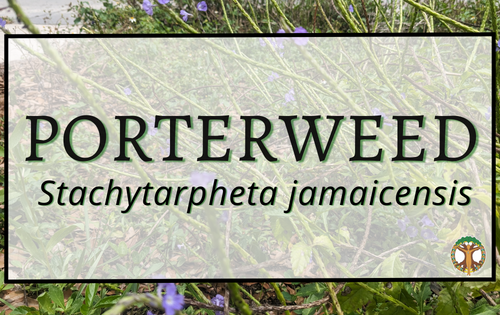
Gotu Kola
- Plant of Month profile contributed by Jessica Grandey
Common Names
Indian pennywort, marsh pennywort, Asiatic pennywort, antanan in Pakistan. In Malay cuisine it is known as pegaga, brahmi booti in Hindi, brahmi in Marathi, saraswati aku in Telugu, kudangal in Malayalam, ondelaga in Kannada, Vallarai keerai in Tamil, brahmi (Sanskrit in Ayurveda-not to be confused with Bacopa monnieri), Pohe kula (Hawaii), man t’ien hsing (Chinese), ji xue sao (TCM) pegagam (Indonesian), hang kor chew (Chinese) or nuoc rau ma (Vietnamese)
Latin Name
Centella asiatica
Family
Apiaceae (The Carrot and parsley family)

Habitat
Native to Asia and naturalized to other tropical climates around the world, Gotu Kola grows easily in the warmer areas in the US. It can also be grown in greenhouses and containers. Gotu Kola is a creeping perennial herb that can be found in shady, marshy areas. It is a water loving plant that can grow in shallow water or moist soil. It will grow as long as the soil isn’t too dry.
It produces fan shaped leaves about the size of an old British penny hence its name Indian penny wort. It’s flowers are quite inconspicuous and develop close to the ground.
Parts Used
Fresh and dried leaves mostly
Whole plant in some traditions (with caution)
From Rosemary Gladstar: “Most of the Gotu kola available commercially is very poor quality. I recommend that, if possible, you grow this important herb or purchase only organically grown Gotu kola from reliable sources.”
History/Tradition
Gotu Kola is the most noted herb used for brain function in Ayurvedic medicine. For thousands of years, it has been used in Asia for food and medicine. In parts of India, Gotu kola is used to engage the crown chakra and as a mild calming sedative taken before meditation and yoga practice.
In Sri Lanka elephants were known to enjoy eating Gotu Kola leaves. Since elephants are renowned for their longevity and memory, the herb earned the reputation as a longevity and memory promoter. There was a Sinhalese proverb that translates something close to, “Two leaves a day keep old age away”
In time, Ayurvedic herbalists found the herb more suited internally and externally to treat skin diseases like leprosy.
In the Philippines Gotu kola has been used to treat wounds and gonorrhea.
Chinese physicians have used it traditionally to treat fever, cold, and chills.
America’s 19th Century Eclectics considered Gotu kola only safe for external applications since eating large amounts causes distress like vertigo.
After WWII, Gotu kola re-emerged as a longevity tonic because of stories that Chinese Herbalist, Li Ching Yun had lived 256 years because of his diet of herbs which included gotu kola.
The leaves of gotu kola have a fanned shape that looks similar to a brain which makes sense with the doctrine of signatures because of its use for circulation to the brain aiding in memory retention.
In the 1880s France began using Gotu kola as a part of regular pharmaceutical medicine.
The Rudolf Stiftung Hospital in Austria helps their patients’ wounds to heal by applying a salve and an injection of the skin repairing compounds extracted from Gotu Kola.
One of the nicknames for Gotu kola is Tiger herb. This comes from a legend that tells of tigers rolling in Gotu kola when wounded to help them heal. Gotu kola is referenced in the Shushruta Samhita and the Charaka Samhita, the two most foundational and authoritative ancient texts on Ayurvedic medicine. One of the preparations “improves memory, intellect, and imparts a celestial glow to the complexion.”
Energetics
Flavor: Acrid, Sweet and Slightly Bitter
Temperature: Cold
Moisture: Dry
Tissue State: Relaxing
Systems
Nervous System
Circulatory System
Integumentary System
Actions
Cerebral Tonic
Antirheumatic
Mild diuretic
Sedative
Peripheral Vasodilator
Nutrition
Vitamin Bs, calcium, pangamic acid, phosphorus, iron, beta carotene, and the amino acid glutamine
Constituents
Triterpinoid saponins (asiaticoside, brahmocide, thankunicide)
Alkaloids (hydrocotyline)
Bitter principles (vellarin)
Benefits
Goto kola improves circulation, increases longevity, is a brain tonic which helps with mental alertness, and aids with fading memory or memory loss. It is a nerve tonic that has been successfully used to treat Alzheimer’s, epilepsy and schizophrenia. It is balancing to the adrenals.
Gotu Kola is used in wound healing. It is thought to speed up the laying down of new blood vessels and collagen formation as well as increasing antioxidant levels within the wound while the tissues are repairing. It has long been used to treat leprosy, skin ulcers, and a variety of skin problems. There is also research from India that it can be used to combat fevers, abdominal disorders, asthma, and bronchitis. Some people have even used an oil extract to promote hair growth. The increase in circulation it promotes makes it a great herb to improve the structure of varicose veins and strengthen connective tissues. Because of its anti-inflammatory effect due to the increase in circulation it is given for rheumatism, rheumatoid arthritis, and poor circulation. Traditionally Gotu Kola is also used for its sedative properties to overcome insomnia and help quiet the mind.
Cautions
Eating large amounts may cause stomach distress because of the saponins. It can also cause dizziness in large doses. It is recommended to work with a professional herbalist or your health specialist if taking large amounts or using the whole plant. Gotu Kola is not at all related to the caffeine-based herbal stimulant, kola nut and caution should be used to distinguish between the two. If you buy pre-made formulations, make sure they do not contain kola nut. Use caution and talk to your healthcare professional if you are using blood thinners but want to take Gotu Kola. Animal studies have shown it safe during pregnancy and lactation. Although no human adverse events have been reported from use during pregnancy and lactation, some sources suggest caution. Talk to your herbalist or healthcare provider. This plant is fantastic at soaking up heavy metals from the soil, so be very cautious where you grow, forage and source from.
Culinary use
Eaten raw in salads and juiced more than anything. The fruit bearing structures are intensely bitter.
The juice drink, bai bua bok is very popular in Thailand and some other parts of that region. Thankuni pata er juice is also popular in Bengal. Gotu Kola is also used in the traditional Bengali dish, shukto and can be used to make Bengali style sabzi daal. In Burmese cuisine the raw leaf is used in a salad mixed with onions, crushed peanuts, bean powder and seasoned with lime juice and fish sauce. In Sri Lanka it is prepared as malluma which is a traditional side for rice and vegetarian dishes. Also in Sri Lanka there is a porridge called kola kenda or kanda. Sri Lankan Sambol is a delicious coconutty salad. In Vietnam and Thailand, some spring rolls will have Gotu kola leaves. In Malay Cuisine, the leaves are used in Ulam which is a vegetable salad. In Bangladesh, they make a pakora with Gotu kola as an ingredient.
Can also be made in pesto, salad, tabbouleh, chutney, stir fry, soups, stew (kootu) curry, smoothies, egg dishes, raw on sandwiches and in wraps.
Other uses
Gotu kola’s magical powers lie in its ability to calm the mind, increase concentration, increase psychic strengths, and activate the crown chakra for use during meditation and yoga. It is an ingredient in meditation incense that is burnt in small amounts prior to meditation. Gotu Kola aids in the heart and mind connection
Tarot Card: High Priestess
Element: Air + Earth
Zodiac Signs : Capricorn & Aquarius
Planet: Saturn
Magic: Divination, monetary gain, lucid dreaming, meditation, psychic powers, virility and fertility. Useful in tantra and sex magic practices.
Incense: blends for clearing energy





